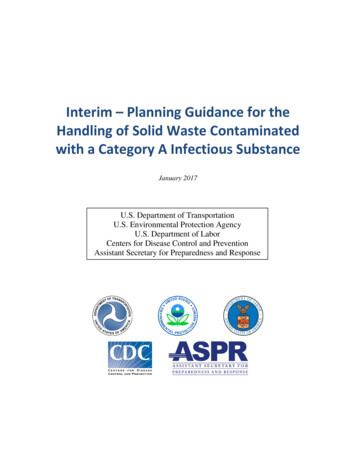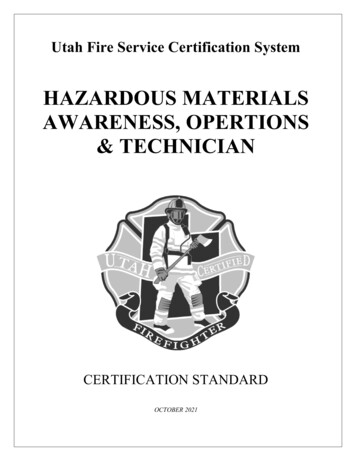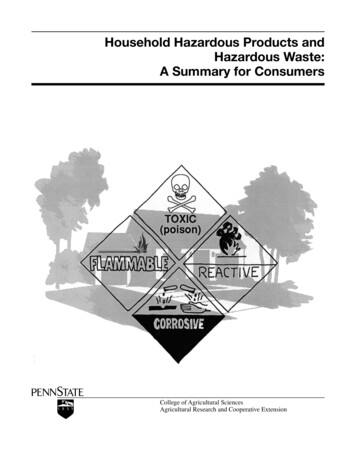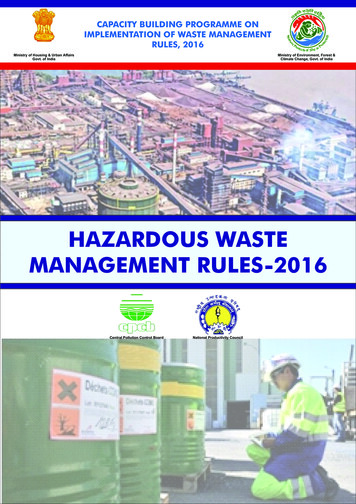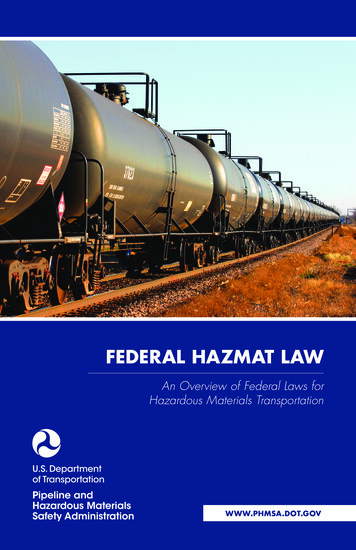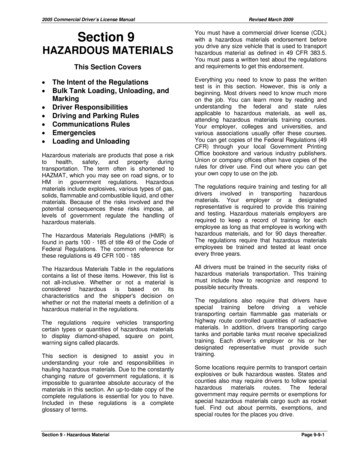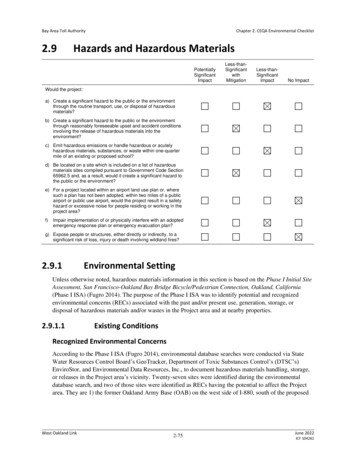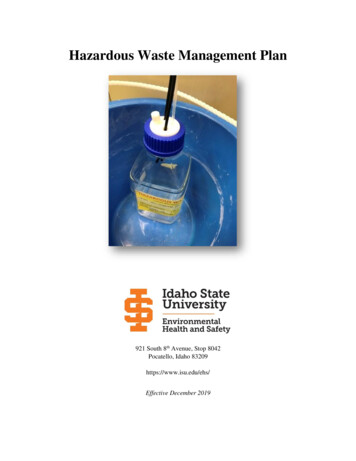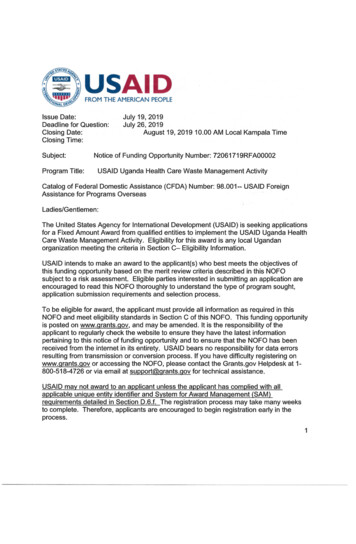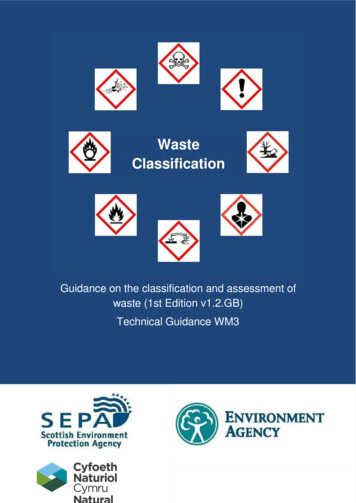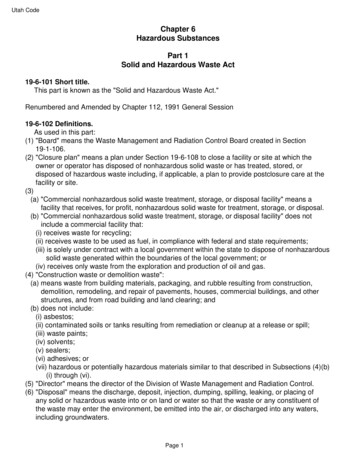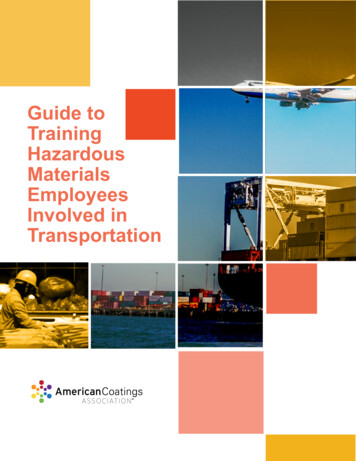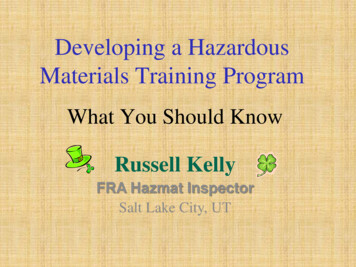
Transcription
Developing a HazardousMaterials Training ProgramWhat You Should KnowRussell KellyFRA Hazmat InspectorSalt Lake City, UT
Effective Training Program Develop Safety Culture Provides Employees with Understanding ofRegulatory Compliance and Railroad Safety Improve Company Effectiveness & Productivity Comply with Special Permits and One-TimeMovement Approvals Prevent Agency Sanctions such as Emergency Orders Prevent Catastrophic Events
Hazmat Training RequirementsGeneral Awareness / FamiliarizationHazmat training designed to provide the employee with sufficient information to recognize& identify hazardous materials consistent with the hazard communication standards.Function SpecificSpecialized training designed to provide sufficient information, skills & knowledge offederal requirements for an individual to safely function in a particular job.SafetyDesigned for employees who handle or transport hazmat & persons with the potential forexposure to hazmat, as a result of a transportation accident. [* Those who repair & testhazmat packagings are not subject to the safety training requirements]Security AwarenessProvides an understanding of security risks.In-Depth Security TrainingDetailed understanding of company security plan requirements.
Hazmat EmployersMust: Provide TrainingTest EmployeesCertifyDevelop & MaintainRecords Recurrent TrainingEvery Three Years
Definition of aHazmat Employee 171.8 Loads, unloads or handles hazmatPrepares the shipment for transportResponsible for transportation safetyRequalifies hazmat packagingsOperates vehicles transporting hazmat
New Employees New hazmat employees or an employee who changes job functions thatrequires DOT training “may” perform those functions only under thedirect supervision of a properly trained & knowledgeable hazmatemployee. DOT training received from other sources “may” be used to satisfy thetraining requirements; however, the current hazmat employer mustdetermine that the DOT training previously received was adequate & theemployer must still certify that the new hazmat employee has beentrained & tested. The employer has 90daysto complete the new hire’s DOT training !
Who May Provide theTraining? Company Employee Outside Training Firms Federal or State Agencies Colleges & Universities Any other organization that can meetthe objectives of the trainingrequirements Computer-based training programs
Evaluate Training Determine Needs» What materials being transported» Employee Duties» Job Hazard Analysis Monitor Effectiveness» Testing both book and proficiency» Employee feedback» Continuous assessment
Use Regulations as Guide forTraining Applicable sections» Training Rule 172h & 172i» Shipping papers 172.200» Marking 172.300» Labeling 172.400» Placarding 172.500» Loading/Unloading 173.31g, 173.31d» Transloading 174.67
Recordkeeping1. Hazmat employee’s name2. Most recent training completiondate3. A copy, description or locationof the training materials4. Name & address of thetrainer(s)5. Certification that the hazmatemployee has been trained &tested
Security Plans172.800(b) New Rules Effective October 1, 2010 As used in this section, “large bulk quantity”refers to a quantity greater than 3,000 kg (6,614pounds) for solids or 3,000 liters (792 gallons)for liquids and gases in a single packaging suchas a cargo tank motor vehicle, portable tank,tank car, or other bulk container.
Applicability (1) Any quantity of a Division 1.1, 1.2, or 1.3 material; (2) A quantity of a Division 1.4, 1.5, or 1.6 material requiringplacarding in accordance with subpart F of this part; (3) A large bulk quantity of Division 2.1 material; (4) A large bulk quantity of Division 2.2 material with a subsidiaryhazard of 5.1; (5) Any quantity of a material poisonous by inhalation, as defined in §171.8 of this subchapter; (6) A large bulk quantity of a Class 3 material meeting the criteria forPacking Group I or II; (7) A quantity of desensitized explosives meeting the definition ofDivision 4.1 or Class 3 material requiring placarding in accordancewith subpart F of this part; (8) A large bulk quantity of a Division 4.2 material meeting the criteriafor Packing Group I or II;
Applicability (9) A quantity of a Division 4.3 material requiring placarding in accordancewith subpart F of this part; (10) A large bulk quantity of a Division 5.1 material in Packing Groups I andII; perchlorates; or ammonium nitrate, ammonium nitrate fertilizers, orammonium nitrate emulsions, suspensions, or gels; (11) Any quantity of organic peroxide, Type B, liquid or solid, temperaturecontrolled; (12) A large bulk quantity of Division 6.1 material (for a material poisonousby inhalation see paragraph (5) above); (13) A select agent or toxin regulated by the Centers for Disease Control andPrevention (14) A quantity of uranium hexafluoride requiring placarding (15) International Atomic Energy Agency (IAEA) Code of Conduct Category1 and 2 materials including Highway Route Controlled quantities as definedin 49 CFR 173.403 or known as radionuclides in forms listed as RAM-QC bythe Nuclear Regulatory Commission;
Security Plan Components Assessment of possible transportationsecurity risk(s) Personnel security Unauthorized access En route Security
Examples of FunctionSpecific Training
Proper Display of Placards
DOT E-14572InhalationHazardMARKINGHOTDOT 111A100W1LiquefiedPetroleum Gas4G/X15/S/99/USA/AJ6522
Identification NumbersMay only be displayed on :Orange PanelsPlacardsWhite square-onpoint configuration3257
Commodity Name Markings on Tank CarsA tank car containing certain materials listed in CFR172.330 must be marked on each side with the “keywords” of the Proper Shipping Name specified inCFR 172.101 Table or a common name authorizedin the regulations (e.g. Refrigerant Gas). Min. 3.9” heightfor rail carsGATX 87554CHLORINELD LMT 180,000 LBLT WT 81,300 LBINHALATION HAZARD
Poisonous by Inhalation Marking Packages must be marked :“INHALATION HAZARD” ! Marked on 2 opposing sides for bulk packagings inletters at least 3.9” in height for rail cars, at least2” in height for other bulk packagings & at least1” for portable tanks 1,000 gals & IBC’s. Transport vehicles & freight containers containingPIH materials in non-bulk packagings must be markedon each side & each end with the IDENTIFICATIONNUMBER for each PIH material if: Material is in Hazard Zone A or Band, Loaded at one facility with 2,205 lbs or more withthe same PIH material
TrainvsSwitchingDefinition of a “Train” – means 1 or more enginescoupled with 1 or more rail cars, except duringswitching operations or where the operation is that ofclassifying and assembling rail cars within a railroadyard for the purpose of making or breaking up trains.- CFR 171.8FRA Interpretation:Except for interchange operations, which are alwaysconsidered “train” movements, the definition of a“train” is applicable if federal air brake rules apply.
Train Placement of HazmatGATX 87746PLMX28841General - The following must be separated from a locomotive oroccupied caboose by at least 1 non-placarded car: Residue tank car RadioactiveTrain Placement Table for “Loaded” Placarded Cars - CFR 174.85 (d)The table utilizes (4) Placard Groups: Placard Group 1 – Explosives (Div. 1.1 & 1.2) * Placard Group 3 – 2.3, Zone A & 6.1, PG I, Zone A * Placard Group 4 – Class 7 (Radioactive) Placard Group 2 – which are all of the other classes/divisions,less the exclusions !* Requires a white square background behind the placard !
Notice to TrainCrews ofPlacarded CarsTrainConsistSwitchListCarrierWaybillBill ofLading174.26The train crew must have a document that reflects thecurrent position in the train of each rail car containingHazmat (load or residue). In addition, a member of thecrew of a train transporting Hazmat must have a copy ofa document for the Hazmat being transported showingthe information required by Part 172 of the subchapter.
Example RR Waybill- IDP RAILROAD COMPANY ********************* DANGEROUS *********************TXPX 33021SACRAMENTOCAKANSAS CITYKSKORTHALS INCIDP, DENVER, JLP4905781PREPAIDWEIGHT AND CHARGES TO FOLLOW1 T/CPROPANE2.1UN1075EMERGENCY CONTACT:800-424-9300HAZMAT STCC 4905781—IDP RAILROAD COMPANY—
Reporting Hazmat Incidents* Immediate Notification * As a direct result of Hazmat:– A person is killed or,– Injury requiring hospitalization– Estimated damages 50,000– Evacuation lasting 1 hour– Radioactive contamination– Etiologic contamination– Release of a Marine Pollutant 119 gal (liquid) or 882 lbs.(solid)
Carrier’sResponsibilities forInspecting HazardousMaterialsAt each location where a hazardous material is acceptedfor transportation or placed in train, the carrier shallinspect each rail car containing hazardous material,at ground level, for required: Markings Labels Placards Securement of closures & leakageThis inspection may be performed in conjunction withinspections required under Parts 215 & 232 of this title.CFR 174.9
Carrier’sResponsibilitiesfor ShippingPapersBILL OF LADINGGATX 834471 T/C Liquefied Petroleum Gas/2.1/ UN1075EMERGENCY CONTACT 1-800-4249300This is to certify that the above named materialsare properly classified, described, packaged,marked and labeled, and are in proper conditionfor transportation according to the applicableregulations of the Department of Transportation.Amanda BlakeA person may not accept or transport a hazardousmaterial by rail unless that person receives a shippingpaper that properly conveys the information required byPart 172 of this subchapter. Only an initial carrier withinthe United States must receive and retain a copy of theshipper’s certification as required by CFR 172.204 ofthis subchapter.- CFR 174.24
174.83HAZMATSWITCHINGCertain loaded, placarded rail cars may NOT be: Cut off while in motion Coupled into with more force than is necessary tocomplete the coupling Struck by any car moving under its own momentumThese shipments are: 1.1 & 1.2 (Explosives) 2.3, Zone A (Poisonous Gases) 6.1, PG I, Zone A ( Poison Liquids) DOT 113 tank car placarded Div. 2.1 (Load or Residue) Placarded flatcar or a flatcar carrying a placardedtransport vehicle, freight container or bulkpackaging
Exclusions from Handling & TrainPlacement Requirements Combustible liquids Class 9(Miscellaneous Hazmat) Div. 6.1,PG III(Poisonous material)1.6 Div. 1.6(Extremely InsensitiveDetonating Substances) ORM-DPG III(Consumer Commodities)EXPLOSIVESN1
POSITION IN TRAIN OF PLACARDED CARS TRANSPORTING HAZARDOUS MATERIALSRESTRICTIONSPlacardGroup 1Rail Car1 When train length permits, placarded car may not be nearerthan the sixth car from the engine or occupied caboose.2 When train length does not permit, placarded car must beplaced near the middle of the train, but not nearer than thesecond car from an engine or occupied caboose.3 A placarded car may not be placed next to an open-top carwhen any of the lading in the open top car protrudes beyondthe car ends, or if the lading shifted, would protrude beyondthe car ends.4 A placarded car may not be placed next to a loaded flat car,except closed TOFC/COFC equipment, auto carriers, and otherspecially-equipped cars with tie-down devices for securingvehicles. Permanent bulk head flat cars are considered thesame as open-top cars.5 A placarded car may not be placed next to any transportvehicle or freight container having an internal combustionengine or an open-flame device in operation.PlacardGroup 2PlacardGroup 3PlacardGroup 4Tank Rail Tank RailRail CarCar Car Car CarXXXXXXXXXXXXXXX(1)Where an “X” appears at the intersection of a Placard Group column & aRestriction row, the corresponding restriction applies !(2)“Rail Car” means a car other than a tank car.(3)For purposes of this subpart, each unit of an articulated intermodal rail car shallbe considered as one car.
POSITION IN TRAIN OF PLACARDED CARS TRANSPORTING HAZARDOUS MATERIALSRESTRICTIONSPlacardGroup 1Rail CarPlacardGroup 2PlacardGroup 3PlacardGroup 4Tank Rail Tank RailRail CarCar Car Car Car6. Placarded cars may not be placed next to each other based on the following:Placard Group 1X X X XXX XXPlacard Group 2XPlacard Group 3XX XPlacard Group 4XX X X XPLACARD GROUP:Group 1 – Divisions 1.1 and 1.2 (Class A explosive) materialsGroup 2 – Division 1.3, 1.4, 1.5 (Class B and C explosive), Class 2 (compressed gas;other than Div. 2.3, Zone A, Class 3 (flammable liquid), Class 4 (flammablesolid), Class 5 (oxidizing), Class 6 (poisonous liquid); other than Div 6.1,PG 1,Zone A, and Class 8 (corrosive materials.Group 3 – Divisions 2.3 (PG I, Zone A; poisonous gas) and 6.1 (PG I, Zone A;poisonous liquid) materials.Group 4 – Class 7 (radioactive) materials.X
direct supervision of a properly trained & knowledgeable hazmat employee. DOT training received from other sources " may " be used to satisfy the training requirements; however, the current hazmat employer must determine that the DOT training previously received was adequate & the employer must still certify
